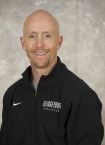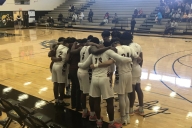You have /5 articles left.
Sign up for a free account or log in.

Mike Lorenzen, Georgetown University
WASHINGTON -- As administrators at Georgetown University followed a string of disconcerting incidents involving athletes and sexual assault at other institutions a few years ago, they wondered how and why something so awful could happen.
It got them thinking about athletes on their own campus. What was the university doing to ensure athletes were learning to make better choices, to be better humans – and, from a risk management perspective, to make sure Georgetown didn’t find itself in the same precarious position as Duke University, the University of Virginia and many others have?
What started as bringing in an outside consultant to speak with students about “leadership,” broadly speaking, evolved into a comprehensive and uncommon institutionalized approach to athlete development. Now in its second year, the Hoyas Lead program joins the forces of the university’s athletics, academics and student services divisions to teach athletes they can – and should – get a whole lot more out of their sport than just wins.
“How do we find that balance? Are we just entertainment, or are we really using athletics as a means to a developmental end?” Mike Lorenzen, Georgetown’s assistant athletic director for student-athlete leadership and development, said in an interview at a small, low-key athletic department lounge. “There’s a lot of hoopla generated by schools that are paying lip service to it but not really investing in a day-to-day, rubber meets the road, look the kid in the eye in a variety of situations and help them deal with their lives and capture the essence of their athletic experience.”
A former head coach, adjunct sports management professor and leadership scholar, Lorenzen has a dossier that makes him uniquely suited to the position, which Georgetown President John J. DeGioia created and funded using his own office’s budget. Lorenzen talks a lot about context: how Hoyas Lead is well-suited to the Jesuit institution whose motto, “Utraque Unum,” speaks to unity and educating the whole person. But he also believes his program is scalable, that it could work at both a Georgetown and an Ohio State.
It’s an intriguing idea that’s gaining traction as the magnitude, influence and visibility of college sports – and the star athletes who make off-field missteps – continues to peak. Indiana University's Excellence Academy is one program similar in scope and approach to Georgetown’s, and Lorenzen has been contacted by institutions across the country that are either considering or committed to creating positions like his.
But the most common approach is what Georgetown started with – hiring an independent consultant, who knows neither the environment he or she is going into nor the athletes and coaches who live in it, to host a few summits or seminars throughout the year. And athletes may sit through a few lectures on sexual assault or substance abuse, but that will be it.
While the study of leadership has taken hold in the academic arena, it hasn’t been institutionalized in athletic departments in the same way – even though athletes seem particularly suited for it.
“We have young people who are forced to deal with suffering, discomfort, dealing with adversity, success. They have to learn to follow, they have to learn to lead, and they do all of this in an ongoing, iterative process every day,” Lorenzen said. “If you believe that [athletics] truly belongs in higher education, it is a unique lab within which we can practice human development.”
Brooke Bachesta, a senior volleyball player, said her experience with Hoyas Lead has prepared her to face “any and all” challenges that lie ahead.
“The program isn’t just about being a good ‘volleyball player’ or ‘team captain,’ it’s teaching us about working with others and problem solving in a way that’s applicable in every other facet of life,” she said in an email.
The program’s second year began with the curricular component: freshmen and sophomores signed up for courses through the normal registration process (they’re not for credit yet, but that is the goal), which cover transition-to-college issues and practical life skills such as planning. Through this academic model, new students begin learning how to progress through college and their sport while paying attention to their own development.
Lorenzen says those classes are “required,” but they’re not technically mandatory. While about 140 of 150 new athletes signed up for them this year, he’s not forcing those who didn’t to do so. (Among those do show up, there are still a few whose body language makes clear they don't think it applies to them. But Lorenzen's found they're responsive when confronted.)
By junior and senior year, athletes aren’t under any obligation – formal or otherwise – to participate in the program. But for those who want to do so through a more experiential-based approach, there are still lectures and seminars, but also practical field work such as working with kids, mentoring, assistant teaching, etc. And for them, Lorenzen also counsels on post-college transition issues and connecting athletes to student services resources.
The framework for freshmen and sophomores is predicated on teaching them how to become influencers even without an official title like student government president. By junior year, it becomes apparent who’s going to actually reach that position in the future, Lorenzen said, which is why he at that point focuses on the smaller, self-selected group that’s bought into the idea.
The academic and co-curricular work is complemented by Lorenzen’s consulting teams on their athletic responsibilities. He attends practice, observing the team’s culture and relationships, what they do well and what they can improve on. Then he meets with athletes – and coaches, in both group seminars and one-on-one consultations – to talk about how they might be better leaders on the field (or the court).
“As much as anything else, it’s listening and providing a reflective resource for both coaches and student-athletes who are sometimes too close to see what’s going on,” Lorenzen said. “When you’re a head coach in a Division I environment, there’s nobody you can really talk to.”
It’s been a welcome resource to Ricky Fried, who in his 10th year as head women’s lacrosse coach acknowledges that he and his colleagues prefer to spend time focusing on “the tactical side of things.”
“For coaches, it isn’t always easy for us,” Fried said of letting someone from the outside come in and take control of even just part of athletes’ focus and development. “But once you see the response from the players, it’s easy to buy in.”
With Lorenzen’s help, Fried and his team have recognized a disengagement among athletes on the sidelines who may show up to practice every day but not necessarily be playing, and instead grow distracted. Now, athletes are being asked to pay more attention to their behavior, and upperclassmen will step in and take an active role. The focus is on the team, not the individual.
“The chemistry on the field hockey team this year is unparalleled and I am lucky to be able to take initiative leading our young team while maintaining an environment free of seniority or other tensions,” Brooke Simone, a junior field hockey player, said in an email. “I have learned critical skills that can not only apply in my future realm of employment, but also in everyday interactions.”
Lorenzen’s impact on the athletes’ post-college lives may be especially significant. While there’s a general sense among athletes that sports teach life lessons – teamwork, goal-setting, sacrifice, etc. – that are important in the workplace, most of that realization doesn’t come to fruition until they’re way out of college, Fried said.
So Lorenzen’s effort to show students exactly what they’re getting, to articulate that and be able to sell it in a cover letter or job interview, could make a big difference.
“At an institution like Georgetown, there is an almost institutionalized sense of inadequacy on the part of student-athletes who know that they got in here because they’re an athlete, and sit in class next to really smart people who got in because of their SATs and their GPAs,” Lorenzen said. “A lot of what we’re doing now is helping them see the value that they get out of their sport and reframing their participation in athletics as a really critical life skill.”








